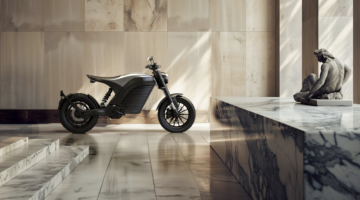Sign up for daily news updates from CleanTechnica on email. Or follow us on Google News!
Before I got into EVs, I was into hypermiling. When everyone else around the shop and the school parking lot were talking about getting more power and lower times, I started to wonder if there was a way to come up with a more efficient commuter that wasn’t a busted Geo Metro that couldn’t sustain highway cruising and air conditioning simultaneously. I got to the point where I was getting 35 MPG out of a V6 Fiero (only a few of the 4 cylinder models got 50 MPG).
So, when I got into EVs, I took the same approach. Like gasoline, EV batteries are expensive. You just have to pay for those batteries all at once while you can bend over for gasoline (here it comes again!) every week or two and take it a little at a time. So, like with hypermiling, I focused on efficiency more than just putting in bigger and bigger batteries.
At the same time, though, not all efficiency can be measured the same way. For example, semi trucks get atrocious MPG compared to even a pickup truck, but that semi can be as heavy as 80,000 lbs (or, 40 tons). When you compare the miles per gallon by the ton, semi trucks end up being more efficient than most vehicles. Sure, getting 5-8 MPG sucks, but when you’re carrying so much stuff that it would take 60 Model 3s to safely carry, it’s not a fair comparison.
So, while we ruthlessly mocked the Hummer EV here for having a giant battery pack and not that much range, GM may have ended up getting the last laugh with the Silverado EV. We don’t know the exact size of the battery, but it’s estimated to be well over 200 kWh! This sounds absurd, but when you want the truck to actually do truck stuff and not act as a mall crawler, a big battery pack and a non-teardrop shape ends up being the right answer.
Let’s start with how it performs on the Rustin Ring Out of Spec runs electric trucks through now: (article continues after)
[embedded content]
When Kyle ran the Cybertruck on this same route loaded similarly, it had no power troubles pulling loads up the steep hills. But, braking was a bit of an issue for the Cybertruck, both in terms of lacking a park lock and lacking adequate regenerative braking to not heat the friction brakes up on the downhills.
The other issue that has been identified is that the Cybertruck’s shape might be a little too optimized for driving without a trailer. The slope in the back is great for driving the truck alone, but it leaves a lot of wind hitting the front of a trailer. So, again, what’s efficient for unloaded driving isn’t always the best choice for a tow vehicle.
Instead of crapping out on regenerative braking like the Cybertruck and the Rivian vehicles have, you can see at about 33 minutes into the video that the Silverado had no problem holding the vehicle back going down the steep hills. Even without trailer brakes, the Silverado maintained speeds without needing any friction. So, it was designed for maximum use and even abuse.
An unloaded Cybertruck was running behind the Silverado EV for use as a camera car, and even unloaded, the Tesla was having limited regenerative braking! So, GM clearly has things a little more figured out.
As for the steep dirt road hill climb, power management seemed to be pretty decent. Just about every truck has some wheel spin on this segment, but the Silverado was very composed. It never ran into power limits, regen limits, or any other limits. It just ran and did the job the whole time.
But What If You Only Tow Sometimes?
Unlike the Hummer EV, the Silverad0’s use of the big Ultium pack is a lot more efficient. So, even unloaded, it isn’t getting those terrible efficiency and range numbers. Another Out of Spec vehicle proves this out:
[embedded content]
I previously covered the first part of this video, and it took a bit both for the full three-part series to come around and for me to watch it! But, it became pretty clear that the Silverado was going to be a serious contender in the road trip race along I-10 from end to end. In these later videos, it became clear that the Silverado was better equipped for the job than the other vehicles. With an unloaded EPA range of over 400 miles, it’s making good use of the power storage available.
By the time they got across Texas, the Cybertruck was ahead of the Silverado. But, when they ran into New Mexico, the Cybertruck was facing a need to charge at slower V2 stations when the Silverado was still getting 350 kW EA stations and didn’t need to stop at them all. This battery advantage, despite more limited infrastructure for CCS vehicles, kept the Silverado competitive.
And, by competitive, I mean that things were close even as the trucks were all headed into Arizona! But, the Cybertruck fell behind again as the Silverado kept going in Willcox and they had to charge the low-poly truck up. By the time they got into California, the drivers were all figuring out how to skip final charging stops. It didn’t always work out, though, with some short final charges needed.
In the end, the Silverado won, but in the future, things might not be the same. Faster V3 and V4 chargers will spread, and the Cybertruck has a lot more potential for charging speed. But, to see a truck that is theoretically less efficient perform ahead of the pack shows us that the Silverado at least isn’t sacrificing unloaded capability for these kinds of unloaded drives.
The only issue is that with the current battery-constrained EV manufacturing scene, the Silverado is probably a little ahead of its time. But, when battery cells are plentiful in the future and prices drop, the approach of using 200+ kWh battery packs for vehicles intended to tow might work out better. But, for now, most electric trucks are probably going to still live in the 100-150 kWh range.
Featured image by GM.
Have a tip for CleanTechnica? Want to advertise? Want to suggest a guest for our CleanTech Talk podcast? Contact us here.
Latest CleanTechnica.TV Video
[embedded content]
Advertisement
CleanTechnica uses affiliate links. See our policy here.
- SEO Powered Content & PR Distribution. Get Amplified Today.
- PlatoData.Network Vertical Generative Ai. Empower Yourself. Access Here.
- PlatoAiStream. Web3 Intelligence. Knowledge Amplified. Access Here.
- PlatoESG. Carbon, CleanTech, Energy, Environment, Solar, Waste Management. Access Here.
- PlatoHealth. Biotech and Clinical Trials Intelligence. Access Here.
- Source: https://cleantechnica.com/2024/04/10/we-may-have-been-wrong-to-mock-gms-big-battery-approach-to-electric-trucks/
- :has
- :is
- :not
- :where
- $UP
- 000
- 2%
- 200
- 33
- 35%
- 350
- 4
- 40
- 400
- 50
- 60
- 80
- 800
- a
- About
- abuse
- across
- Act
- actually
- adequate
- ADvantage
- Advertise
- Affiliate
- After
- again
- ahead
- AIR
- Air Conditioning
- All
- alone
- along
- always
- an
- and
- Another
- answer
- any
- approach
- ARE
- around
- article
- AS
- At
- available
- back
- batteries
- battery
- BE
- became
- been
- behind
- being
- BEST
- Better
- Big
- bigger
- Bit
- both
- but
- by
- california
- camera
- CAN
- capability
- car
- carry
- carrying
- Cells
- challenge
- charge
- charges
- charging
- choice
- cleantech
- Cleantech Talk
- clear
- clearly
- climb
- Close
- come
- comes
- compare
- compared
- comparison
- competitive
- composed
- content
- continues
- covered
- crawler
- Current
- cybertruck
- designed
- Despite
- DID
- dirt
- do
- Dont
- down
- drivers
- drives
- driving
- Drop
- EA
- efficiency
- efficient
- Electric
- electric vehicle
- else
- embedded
- end
- ended
- ends
- EPA
- equipped
- estimated
- Ether (ETH)
- EV
- EV batteries
- Even
- Every
- everyone
- evs
- exact
- example
- expensive
- facing
- fair
- faster
- few
- figured
- final
- finish
- First
- focused
- For
- friction
- from
- front
- full
- future
- gasoline
- get
- getting
- giant
- GM
- going
- good
- got
- great
- Guest
- had
- Have
- having
- headed
- heavy
- here
- Highway
- Hills
- hitting
- holding
- How
- How To
- HTTPS
- i
- identified
- if
- image
- in
- Infrastructure
- intended
- into
- issue
- IT
- ITS
- Job
- just
- kept
- kinds
- Know
- kyle
- lacking
- Last
- later
- laugh
- least
- leaves
- less
- lightning
- like
- Limited
- limits
- Line
- links
- little
- live
- loads
- lock
- Lot
- lower
- maintained
- Making
- management
- manufacturing
- max-width
- maximum
- May..
- me
- mean
- measured
- Metro
- Mexico
- might
- minutes
- model
- models
- more
- more efficient
- most
- much
- Need
- needed
- needing
- never
- New
- news
- no
- now
- numbers
- ocean
- of
- on
- once
- only
- optimized
- or
- Other
- our
- out
- over
- Pack
- Packs
- Park
- parking
- part
- Pay
- per
- perform
- performs
- Pickup
- plato
- Plato Data Intelligence
- PlatoData
- player
- podcast
- Point
- policy
- potential
- power
- pretty
- Prices
- probably
- Problem
- proves
- pulling
- Putting
- Race
- ran
- range
- regenerative
- right
- Ring
- rivian
- road
- Route
- running
- runs
- s
- sacrificing
- safely
- same
- scene
- School
- see
- seemed
- segment
- Semi
- Series
- serious
- setting
- Shape
- Shop
- Short
- Shows
- Similarly
- simultaneously
- Size
- Slope
- slower
- So
- some
- sometimes
- sounds
- speed
- speeds
- Spin
- spread
- start
- started
- Stations
- steep
- Still
- Stop
- Stops
- storage
- stuff
- suggest
- sure
- Take
- Talk
- talking
- terms
- terrible
- Tesla
- texas
- than
- that
- The
- The Future
- Them
- theoretically
- There.
- These
- they
- things
- this
- those
- though?
- Through
- time
- times
- tip
- to
- Ton
- tons
- too
- took
- trailer
- trip
- truck
- Trucks
- tv
- two
- Updates
- us
- use
- uses
- using
- vehicle
- Vehicles
- very
- Video
- Videos
- vs
- want
- was
- Watch
- Way..
- we
- week
- WELL
- were
- What
- Wheel
- when
- while
- whole
- will
- wind
- with
- without
- Won
- wonder
- Work
- work out
- would
- Wrong
- you
- youtube
- zephyrnet








